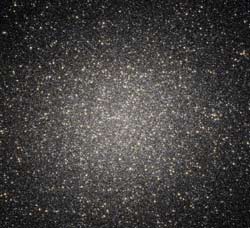So of course as soon as I take a trip to LA and am really busy, a whole pile of astronomy news pours out when it had hitherto been a slow week. I suspect a lot of these will have more details at the NAM website, so check there too.
1)  Omega Centauri may be a galaxy. Omega Cen is a globular cluster, a giant ball of millions of stars. These beehive-looking objects are very pretty and very old; some as old or older than the galaxy itself. The Milky Way has well over 100 of them orbiting it. The thing is, Omega Cen is a lot more massive than any other globular, and astronomers have suspected it’s actually a dwarf galaxy. New studies using Hubble and Gemini South have found an intermediate mass black hole in its core, a black hole bigger than one that forms when a star explodes, but smaller than the ones found in the centers of big galaxies. In this case, it has about 40,000 times the mass of the Sun. These are difficult to form, and harder to find – this one was found using the relative motions of stars near the center of Omega Cen. A black hole of this mass is unexpected in globulars, but is about the right size for a dwarf galaxy. This lends credence to the idea that Omega Cen is misclassified.
Omega Centauri may be a galaxy. Omega Cen is a globular cluster, a giant ball of millions of stars. These beehive-looking objects are very pretty and very old; some as old or older than the galaxy itself. The Milky Way has well over 100 of them orbiting it. The thing is, Omega Cen is a lot more massive than any other globular, and astronomers have suspected it’s actually a dwarf galaxy. New studies using Hubble and Gemini South have found an intermediate mass black hole in its core, a black hole bigger than one that forms when a star explodes, but smaller than the ones found in the centers of big galaxies. In this case, it has about 40,000 times the mass of the Sun. These are difficult to form, and harder to find – this one was found using the relative motions of stars near the center of Omega Cen. A black hole of this mass is unexpected in globulars, but is about the right size for a dwarf galaxy. This lends credence to the idea that Omega Cen is misclassified.
2) Astronomers see a nascent world. Astronomers using a radio telescope to observe the nearby low-mass star HL Tau were surprised to see a large clump of material near the star. Turns out it’s a planet forming as we watch! It’s more massive than Jupiter, and twice as far out from HL Tau a Neptune is from the Sun. HL Tau is only 520 light years away, giving us a pretty good view. The disk and star are only 100,000 years old, which is incredibly young to be seeing something like this! For comparison the Earth is 6000 4.6 billion years old.
3) Lightweight black hole. Using a brand new technique, astronomers have identified the lowest mass black hole ever found. Orbiting a star like the Sun, the black hole has an estimated mass of 3.6 times the Sun’s mass, a little more than half the mass of the previously known lightweight hole. The new technique is quite complicated, involving measuring the change in the brightness of X-rays coming from a black hole as it gulps down matter from its companion star. The scientists tested the method using black holes with well-known masses, and their results agreed, so they are confident their new result on this bantam black hole are accurate. This very cool news; the lowest mass a black hole can have is only about 3 times the mass of the Sun (black holes forms when the core of a massive star collapses, and it takes that much mass to make a black hole, otherwise a less-dense neutron star forms), so this one is very near the limit. Studying black holes like this one will tell us a lot about how they form, but we have to find them first! So this method is promising.
OK, that’s it for now. I have to go and do movie-star stuff, and it’s a dead certainty I can’t keep up with the astro-firehose this week will be from the meeting in the UK. Like I said above, go to the NAM site or Universe Today to keep up with the latest.